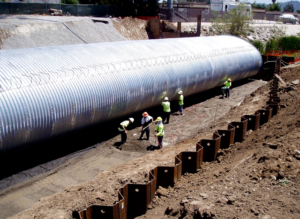In the ground improvement industry, there are a handful of different technologies to choose from when developing a solution for a project. Varying factors that can weigh into which method will be the most successful and financially feasible include soil type, experience, construction timelines, equipment needs and more.
Traditionally, our industry has relied upon tried-and-true conventional driven sheet piling methods to provide earth retention, dewatering needs, and excavation support. Alternatively, cement deep soil mixing (CDSM), a more modern process being used across the sector today, has become an enticing approach due to the more cost-effective properties it holds. Both are efficient methods that are commonly used but understanding where they hold more value is important for achieving optimal results and high levels of satisfaction from the client.
Following is a deep dive in the uses and benefits of driven sheet piling versus CDSM temporary earth retention, dewatering needs, and excavation support.

The Basics of Traditional Driven Sheet Piling:
Driven sheet piling is typically used to create temporary and permanent walls that provide excavation support and soil retention. Sheet piles are designed to interlock with each other and installed in a continuous sequence throughout the planned perimeter, in order to form a wall while anchors can be positioned simultaneously to provide additional lateral support, where required. The installation process often requires a vibratory hammer for ground penetration or impact hammers if the material is too dense. However, if the ground is softer and conditions are suitable, utilizing hydraulic force is another option.

The More Modern Approach of CDSM:
CDSM is a ground improvement method that blends cement with native soils in situ to improve strength and stiffness of the site; to decrease settlement; increase bearing capacity; and mitigate any seismic issues. Additionally, it is used to form walls for excavational support, acts as a contamination barrier, and helps to maintain erosion control.
Implementation requires that a revolving hollow shaft with mixing paddles and/or a section of the mixing tool is advanced into the soil. Once this takes place, the cement grout is pumped through the hollow stem of the revolving shaft and discharged laterally along the lower mixing paddle and incorporated into the native soil. When the desired depth level is reached, the tool is withdrawn while the rotational speed of the mixing tool is concurrently either maintained or increased. This process produces a well-blended mixture of soil and cement grout, which is then cured for a varying amount of time dependent on the needs of the specific job site.
CDSM vs. Driven Sheet Piles – Benefits Assessment and Analysis
Both solutions carry value, so it’s important to factor in the particular needs of the jobsite with the owner and other decision makers on the project to determine the advantages or disadvantages of each technique before moving forward with construction. Before ever groundbreaking, AGI conducts a thorough analysis for its clients by rating the different attributes of the potential solutions being considered. The following is an example of this process.
In a recent project AGI was tasked with creating a ground improvement solution that would provide excavation support and water control for a large grain terminal rail receiving pit in Vancouver, British Columbia. After deliberating between the two methods as shown in the below rating chart, the CDSM approach was deemed to be the best option for the particular job in question. The installed CDSM cut-off walls along the perimeter of the rail receiving pit combined with a bottom seal treatment created a “bathtub” like configuration that allowed for more sufficient temporary lateral support while also mitigating infiltration of at-grade groundwater levels during the next phase of construction. In turn, CDSM was an obvious choice over driven sheet piles for a variety of reasons. However, this decision did not come to fruition without first being compared against driven sheet piling techniques. With a rating system from 1 to 5, with 5 being most favorable, AGI identified attributes from both techniques with the owner ahead of finalizing the design build plan to ensure the most optimal results:
| Cement Deep Soil Mixing | Installation causes little disturbance/vibration | ✅✅✅✅✅ |
| Minimizes water infiltration and minimizes need for large water pumps and post water treatment | ✅✅✅✅✅ | |
| Disposal of excess spoils | ✅✅ | |
| Can bypass obstructions <6″ in diameter | ✅✅✅✅✅ | |
| Can bypass complex fills, boulders and other large obstructions | ✅ | |
| Can minimize water infiltration into temporary excavation | ✅✅✅✅✅ | |
| Works well with sandy soils and soft clays | ✅✅✅✅✅ | |
| Attributes for excavation and water retention application* | ||
| Driven Sheet Piles | Installation causes little disturbance/vibration | ✅ |
| Minimizes water infiltration and minimizes need for large water pumps and post water treatment | ✅ | |
| Disposal of excess spoils | ✅✅✅✅✅ | |
| Can bypass obstructions <6″ in diameter | ✅✅✅✅ | |
| Can bypass complex fills, boulders and other large obstructions | ✅ | |
| Can minimize water infiltration into temporary excavation | ✅ | |
| Works well with sandy soils and soft clays | ✅✅✅✅✅ | |
| Attributes for excavation and water retention application* | ||
So, Which Technique Provides the Most Value?
Ultimately, choosing between a driven sheet piling vs. CDSM approach falls on the needs of the specific job, the client’s desired results and the conditions of the soil. In the above-mentioned project, CDSM was the most viable option but in a different jobsite setting, driven sheet piling could be the more feasible solution. For this reason, it’s always important to partner with a ground improvement firm, like AGI, that will provide strategic counsel to help meet the full intent and needs of the original design; ensure substantial cost savings to the project owner; and achieve optimal foundational and overall project results.
If you are unsure of which technique is right for your next project, whether it’s between driven sheet piling and CDSM techniques, or a variety of other ground improvement methods, contact AGI today and we can help create a customized design-build solution to meet and exceed all of your jobsite needs.
